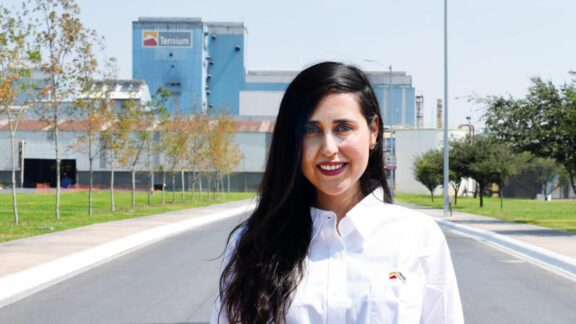Hans-Jürgen Zeiher is not only one of Primetals Technologies’ most trusted managers but also a skilled and experienced technician. As an automation and drives expert particularly in the downstream area, he has personally
participated in the start-up of numerous projects and led the efforts behind many more. Zeiher has been serving as Global Head of the Business Segment Electrics & Automation, since the start of Primetals Technologies in 2015. Metals Magazine sat down with him to discuss the impact of digitalization on the metals industry.

What in your view are the main targets for digitalization in the steel industry?
Hans-Jürgen Zeiher: For me, digitalization has some very clear objectives: it will make the steel-production process more flexible, raise end-product quality, and increase overall plant efficiency. At the same time, it will help to minimize raw-material costs and energy consumption. Also, a fully digitalized production facility requires a far lower operations and maintenance effort.
How many years will it take for digitalization to fully “arrive” in the steel industry?
Hans-Jürgen Zeiher: There is no one answer to this question. Some of our customers already own highly advanced plants, and many of the processes taking place in their facilities are led and captured by sophisticated software. Other customers still rely on Excel sheets to plan their production. How long it will take for these customers to have their plants fully upgraded varies greatly. What is true for almost every steel producer is that the pressure to modernize has increased. Europeans and East Asians probably feel the urgency the most.
At Metals Magazine, we have found that there is still substantial insecurity about the impact of digitalization—even among seasoned technologists. Have you discovered any popular misconceptions about what digitalization will change?
Hans-Jürgen Zeiher: I think that Industry 4.0 as a concept was never properly fleshed out by those who created it, and therefore has remained somewhat vague. Our interpretation of it is this: In a typical steel-production plant, many processes are already highly automated, but largely they are still operating on their own. The challenge is to end this isolation and integrate everything into one comprehensive network by a holistic approach towards digitalization. On the basis of such a system, steel producers can serve their end customers in completely new ways, with higher degrees of customization regarding product specifications and lot sizes. Recent developments in hardware, software, and especially data analysis have made all of this possible.
Is it true that when it comes to advanced automation, the steel industry has been ahead of discrete manufacturing and other areas for a long time?
Hans-Jürgen Zeiher: Definitely. I think that our industry is about 25 years ahead of almost everyone else.
Is the linking of existing technologies for an increasingly digitalized production the main challenge?
Hans-Jürgen Zeiher: Yes, this will be the key to a successful digitalization strategy in our field. Steel-production equipment is simply so expensive that no company will be willing to replace everything they have been using successfully up to now. Our job then is to determine which upgrade packages a customer needs to sufficiently improve the existing plant in order to reach compatibility with today’s technologies and market requirements. We often have to enable old equipment to communicate with newer solutions, so that all plant activity can be monitored and controlled in a unified manner. At Primetals Technologies, we have built a unique competence profile that is widely recognized within the industry: we combine classic automation skills with deep knowledge about the metallurgical process. We are using these capabilities to support our customers in developing the right digitalization strategies based on their current equipment. And we are regularly approached about entering new partnerships to create completely new automation solutions.
Artificial intelligence is a much-discussed if somewhat vague subject matter these days. Will artificial intelligence be a cornerstone of the steel plant of the future, and if so how?
Hans-Jürgen Zeiher: For me, the key question is to what degree self-learning algorithms might at some point replace our traditional physics-based approach. Theoretically, we could see some major technological shifts or disruptions in the future. Therefore, we are actively conducting company-wide research to stay ahead of everyone else. Of course, I don’t believe that our tried-and-tested methods will become obsolete any time soon. But there might be disruptive changes from big-data analytics that could speed up certain parts of our work in the future.
Should steel producers be worried about falling behind? What should they focus on?
Hans-Jürgen Zeiher: I think that those steel producers who are currently leading the industry will have to work even harder on pushing the envelope in order to maintain their position. Companies from the Far East are beginning to catch up technologically, and faster than many expected. It is very important to be realistic about this development—but it is also essential not to overreact and throw in the towel. Many high-end producers are addressing this issue sensibly, for instance, by approaching us about partnerships to create new solutions that will further improve their plants’ efficiency and end-product quality.
What are the top three measures that steel producers should take in order to meet the trend toward more computer-controlled processes?
Hans-Jürgen Zeiher: Our holistic take on steel production—and in particular on the future of steel production—implies that software systems which can integrate all production-related processes are arguably the most crucial factor. We are talking about a “Digital Unity” of three systems: a computer-backed maintenance system that is based on expert knowledge but can be used by regular workers, a quality-management system such as our Through-Process Optimization, and a state-of-the-art production-management system. Importantly, these three systems need to harmoniously interact with one another.
Which solution of the “Industry 4.0” portfolio that Primetals Technologies has established do you consider particularly remarkable, and why?
Hans-Jürgen Zeiher: We have just recently seen remarkable success with big-data analytics from our technology experts. For a Chinese customer, we were able to isolate the source of hardness deviations that occurred at the rolling stage. Initially, the reasons were completely unknown. The Primetals Technologies team was able to pinpoint the origin of the problem by use of our Through-Process Quality Control software in combination with advanced data analytics. In other words, we combined our deep process know-how with the power of big data to narrow down the relevant process parameters. Our customer is now able to reliably reproduce the improved end-product quality levels. I consider that an impressive achievement, and I am intrigued by the technology that made it possible.


